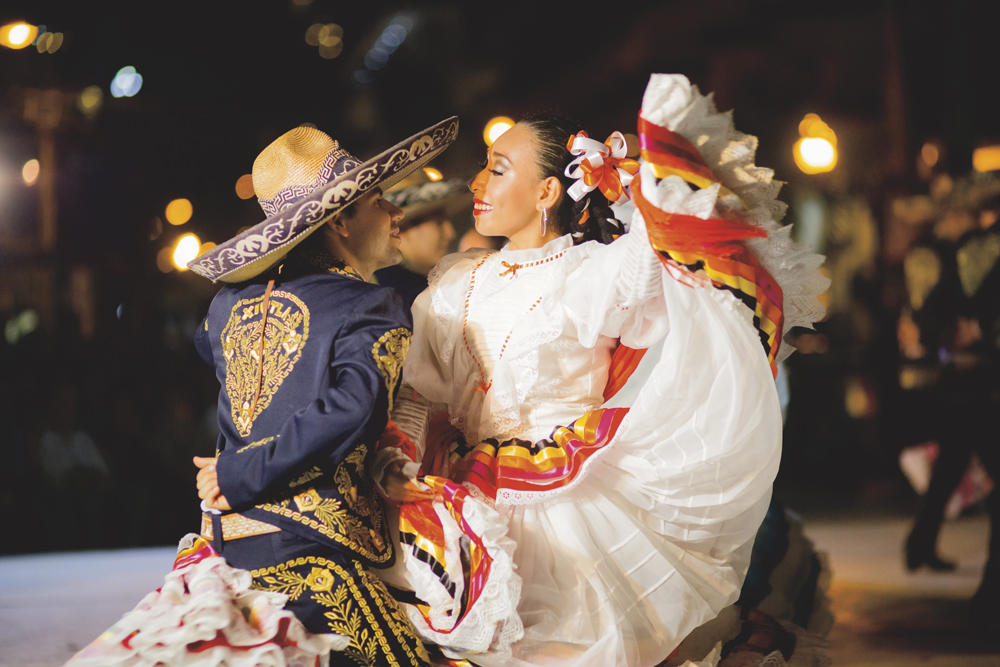Mexico’s Folk Dances: Costumes and Features

Mexico’s various folk dances are a reflection of the country’s diverse cultural richness. With distinguishing features determined by their place of origin, the vast majority of these dances bear traces of European and indigenous influences. The dancers’ regional costumes and the musical accompaniment, often live, contribute to making these performances colorful, festive and entertaining.
Fortunately, visitors to Puerto Vallarta with an appetite for Mexican culture have access to assorted groups presenting many of Mexico’s most popular traditional dances.
Since Mexico comprises various regions, each dance has specific characteristics based on its origins. But what elements should viewers take into account? We approached Jesús Salcedo, a professional dancer with Grupo Cuicacalco with almost 30 years of experience in Puerto Vallarta, to provide an overview of Mexico’s three most representative choreographies.
Jarabe tapatío (the national dance of Mexico)
Better known in the USA as the Mexican hat dance, the choreography represents a man’s courtship of a woman at a party. At first, she rejects his attentions, but ultimately accepts his overtures. When the man sets his charro (Mexican horseman) hat on the floor, they both dance around it. At the end of the dance, the woman picks up the hat and covers both their faces with it, implying that they are sealing their commitment with a kiss.
Costumes
· Woman
Everything she wears is very colorful: a long, full skirt and a long-sleeved blouse decorated with ribbons, her braided hair adorned with wide ribbons in typical Mexican colors. She wears mid-calf boots.
· Man
He wears the traditional charro (Mexican horseman) suit, usually black, with buttons and silver embellishments. Under the jacket he wears a white shirt accented with a brightly colored neckerchief tied in a bow. Both the hat and boots must be color-coordinated with the suit. A belt with intricately woven designs is essential.
The son of La Negra
Despite what you might expect, this song is based on a locomotive. The beginning resembles (supposedly) the sound of a train as it begins to move. One of the song’s phrases, “ojos de papel volando,” (“flying eyes of paper”) refers to the flags that almost all train cars carried during the Mexican Independence era, waving in the wind.
Costumes
· Woman
She wears a very full, ruffled poplin skirt in a bright color, such as red, Mexican pink, yellow or blue, striped with colorful ribbons. The top has elbow-length sleeves and a bibbed front. Her hair is braided and adorned with wide ribbons, and she wears black ankle boots.
· Man
He wears black boots, gray- and black-striped trousers, a red sash, an embroidered white shirt, a neckerchief tied in a bow, a wide-brimmed hat and a serape.
La Bamba (the anthem of Veracruz)
This is one of the most popular songs in the state of Veracruz. It is interpreted as a pair of lovers who, as the choreography progresses, place a red sash on the floor and dance around it. At the end, using only their feet, they tie it into a bow with which they metaphorically seal their commitment.
Costumes
· Woman
Her outfit is completely white, with a long, full, sheer, flounced skirt trimmed with lace, and a sleeveless top. She also wears a black velvet apron, embroidered with colorful flowers, around her waist, with a sash to the side, and a red shawl. She holds a white fan, and wears bracelets, large earrings, gold necklaces and white shoes. Her hair is worn in a bun, surrounded by a garland of red and white flowers and topped with a Spanish comb.
· Man
His outfit is simpler, just white pants and long-sleeved pleated shirt, a bandana around his neck and a hat of woven palm leaves. Black boots are ideal, although white are often worn for aesthetics.


Comments